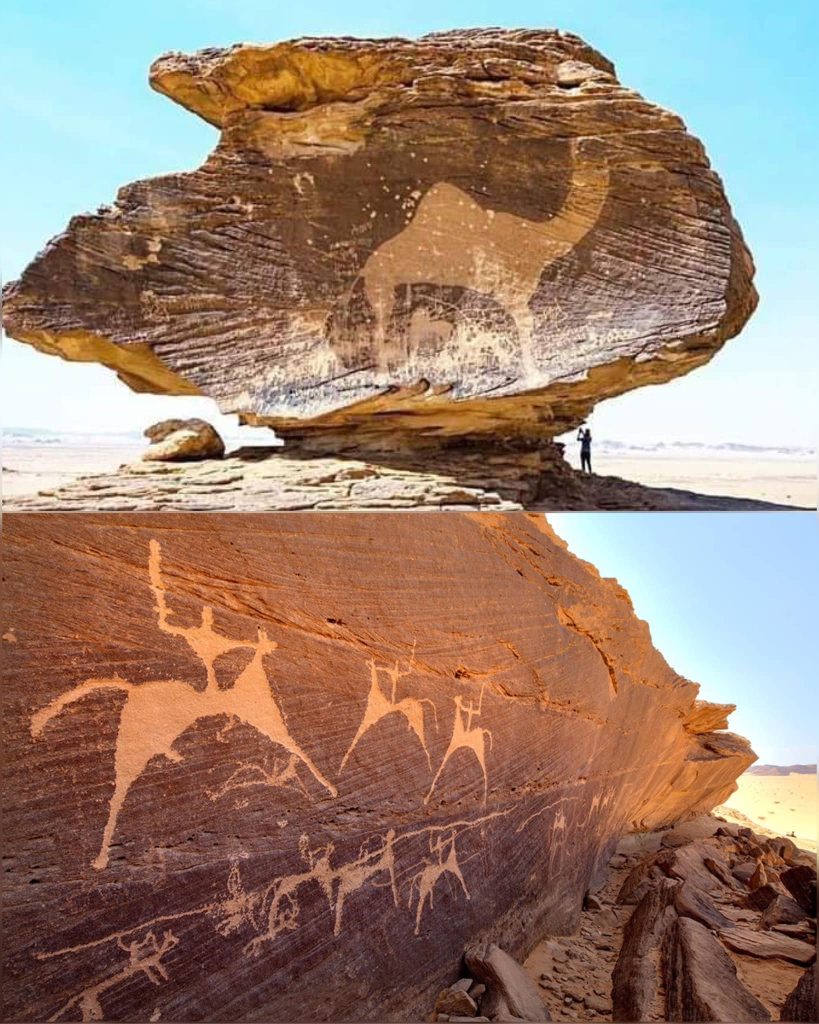Bi’r Hima, situated in the heart of southwestern Saudi Arabia, is one of the most significant archaeological sites in the world. It is home to an extraordinary collection of ancient rock art and inscriptions that span over 7,000 years. This UNESCO World Heritage site provides a rare and invaluable glimpse into the lives, beliefs, and traditions of ancient Arabian communities. Far beyond a mere showcase of petroglyphs, Bi’r Hima serves as a timeless testament to a vibrant culture where survival, art, and spirituality coexisted within the vast desert landscape.
The richness of Bi’r Hima’s rock art lies in its vivid depictions of animals such as camels, ibexes, ostriches, and even lions. These images transport us to a distant past when the environment was greener and capable of sustaining a diverse range of wildlife. These carvings illustrate more than the animals themselves; they also reveal interactions between humans and animals, capturing hunting scenes, pastoral activities, and the tools used by early societies. Each etched scene preserves a piece of everyday life, enabling archaeologists to reconstruct the environmental and social conditions of that era. It is extraordinarily rare to find such detailed representations of human existence stretching across millennia. The petroglyphs at Bi’r Hima stand as evidence of human creativity and resilience, marking the site as a hub of cultural and artistic expression in the ancient Arabian Peninsula.

What makes Bi’r Hima even more remarkable is its strategic position along ancient trade routes. Long before modern infrastructure, this region served as a critical waypoint on the incense trade route, linking the riches of southern Arabia, such as frankincense and myrrh, with Mediterranean markets. These trade networks brought not only goods but also ideas, languages, and cultures, transforming Bi’r Hima into a crossroads of civilization. The inscriptions found at the site, written in early scripts such as Musnad and Aramaic-Nabatean, highlight the multicultural interactions that occurred here. The presence of multiple languages suggests that Bi’r Hima was a meeting ground where South Arabian, Nabatean, and early Arabic cultural elements merged. Traders and travelers likely communicated, exchanged stories, and built alliances here, cementing the site’s role as a melting pot in the desert. These cultural exchanges also likely extended to religious beliefs, as evidenced by the symbols of early deities and ritualistic carvings, hinting at a shared spiritual heritage that transcended borders.
Beyond its role as a center of commerce and cultural exchange, Bi’r Hima appears to have been a site of profound spiritual and social significance. Many historians speculate that the rock carvings represent more than simple artistic expression. They may commemorate tribal gatherings, spiritual ceremonies, or even peace agreements made between different groups. Certain recurring motifs, such as religious symbols and ceremonial figures, suggest that Bi’r Hima held a sacred status. Travelers and locals may have gathered here to honor their gods, ancestors, and shared traditions. These symbols also provide insights into the social values and dynamics of early Arabian society. By studying the inscriptions, archaeologists are uncovering the complexities of kinship networks, social hierarchies, and the values that shaped these communities. The carvings are not merely works of art; they are records of a sophisticated society where spirituality, social structure, and respect for nature were deeply interwoven.
Bi’r Hima’s importance has only grown since its inclusion on the UNESCO World Heritage list, becoming the sixth site in Saudi Arabia to receive this prestigious designation. This recognition has brought global attention to the rich history of the Arabian Peninsula, a region often overlooked in favor of other ancient civilizations. Today, efforts to preserve Bi’r Hima are ongoing, with archaeologists continuing to uncover new insights that enrich our understanding of the past. The petroglyphs and inscriptions serve as powerful reminders that this region was not a forgotten corner of the ancient world but a thriving epicenter of trade, cultural exchange, and spiritual reflection.
For modern viewers, Bi’r Hima challenges long-held perceptions about ancient Arabia. Historically, the Arabian Peninsula was often viewed as little more than a transit point for goods. However, the rock art and inscriptions at Bi’r Hima reveal a far more dynamic reality. This was a cultural ecosystem where people from diverse backgrounds converged to share ideas, trade goods, and celebrate shared beliefs. The site offers a deeper understanding of the historical connections that bind humanity across time and geography. Bi’r Hima reminds us that these connections are not new; they are rooted in centuries of interaction and shared experience.
Bi’r Hima’s enduring legacy lies in its ability to capture the resilience and unity of ancient Arabian people. Each petroglyph and inscription tells a story of survival, adaptation, and the human desire to leave a lasting mark on the world. These ancient artists and scribes, working in a desert environment once thought barren and inhospitable, documented their lives with remarkable detail. The images of hunts, pastoral scenes, and spiritual symbols are windows into a world that was rich in culture, creativity, and connection. Their carvings are messages across time, calling on us to remember the ingenuity and resilience of our ancestors.
As historians and archaeologists continue to study Bi’r Hima, its importance only deepens. The site sheds light on the vibrant lives of those who once thrived in the Arabian Peninsula and the connections they forged across regions. Far from being relics of a forgotten past, the stories etched into Bi’r Hima’s stones are living messages. They remind us of the complexity, unity, and resilience that define the human experience. In doing so, Bi’r Hima serves as both a monument to the past and an inspiration for the present, encouraging us to appreciate the deep connections that bind us across time, geography, and culture.





